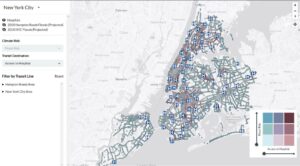Data Clinic is proud to launch TREC (Transit Resilience for Essential Commuting) today at The Opportunity Project Summit, hosted by the US Census. This open source tool aims to provide users with a more human-centered perspective on the impact climate events can have on public transportation.
The Challenge
In the fall of 2022, Data Clinic took part in The Opportunity Project for the first time as part of the Building Climate Change Resilience Through Public Transit sprint sponsored by the US Department of Transportation. These events, organized by the US Census in partnership with federal agencies, aim to demonstrate the value of open data and spur innovation in the nation’s toughest challenges.
Across our many conversations with transit officials, researchers, and community organizers from across the country about the climate-related challenges and opportunities transportation systems face, a recurring theme was the desire to better understand climate’s intersectional impact on both transit and communities. In other words, a flooded bus stop doesn’t just mean that the bus and passengers can’t access the stop. It may also impede access to a hospital, community support, or to a large number of essential jobs. How could we share that insight more effectively?
TREC
TREC, our latest open source tool, seeks to fill that intersectional gap by allowing users to efficiently assess the climate risk for transit stations within the context of the access it provides to vital services and regions. TREC allows users to explore our open data-derived, station-specific risk and access ratings, and easily filter those with the highest climate risk and highest importance for access.
We have initially focused on flooding, the most prevalent climate event facing transit officials across the country, and access to hospitals and jobs to demonstrate the concept. We aim to expand features and functionality in accordance with user feedback.
Our hope is that this human-centered and geospatial approach to the intersectional impact of climate change on transit and communities will give transit planners a more holistic picture to inform their infrastructure improvement decision-making. Further, we hope that making localized climate resilience tools like this open source, user-friendly, and publicly available, will empower community organizations to advocate for their underserved constituents.
The climate crisis we face requires collective intelligence and creative problem solving, and democratizing access to these kinds of tools will be crucial in making progress.
You can visit TREC, contribute to the TREC repo with feedback and feature requests, and view the gallery of solutions developed across The Opportunity Project’s many Sprints.
We’ll be hosting a deeper dive into the design decisions and methodologies that feed into TREC on Monday March 13th from 12pm-1pm ET as part of NYC Open Data Week. You can sign up free to join in-person or virtually.







